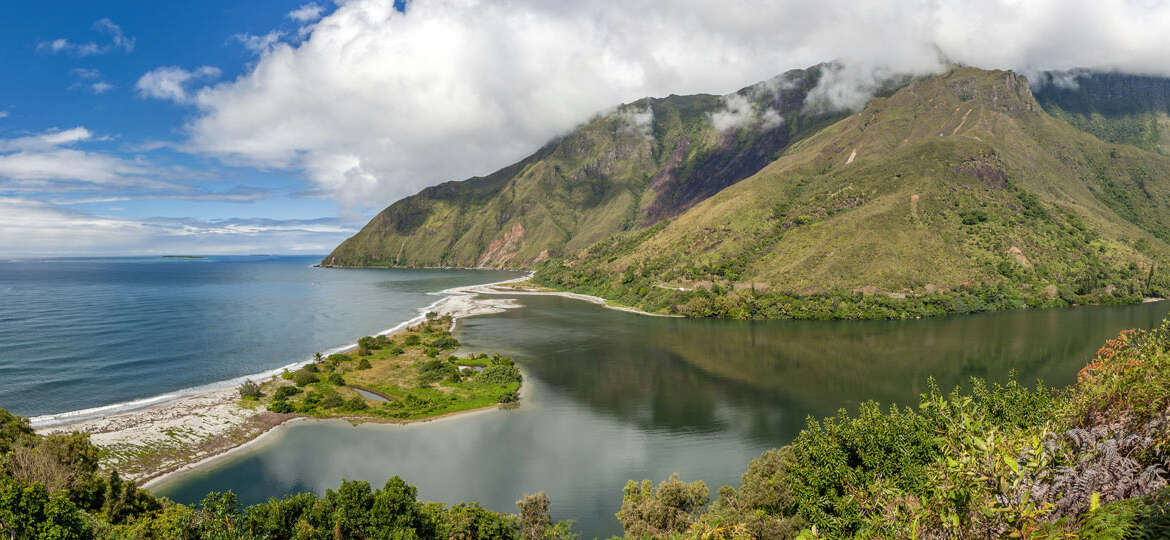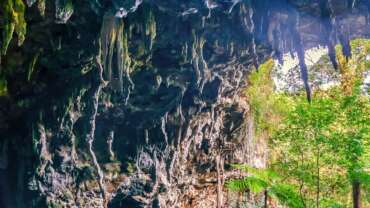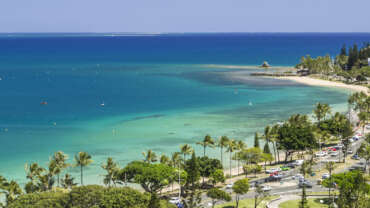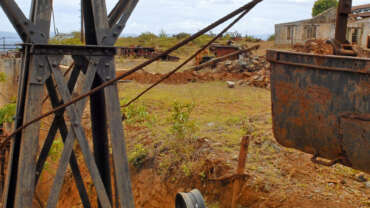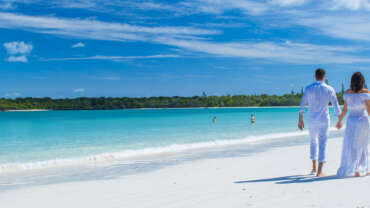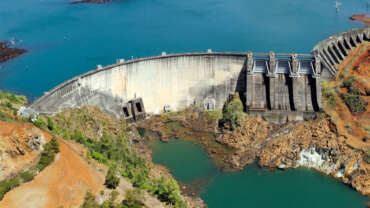East Coast of New Caledonia
The central mountain range of the Mainland (Grande Terre) is a natural boundary, overlooking the very different faces of the East and West Coasts. Exposed to strong winds and therefore more humid, the eastern coast offers scenery with sumptuous flora. With a population of largely Melanesian origin, the East Coast has also retained a particularly charming flavour of authenticity.
From Pouebo to Ponerihouen, the East Coast unfolds along a narrow coastal strip set between the central mountain range and the ocean, a spectacular panorama. Communes located along this magnificent road, Hienghène, Touho, Pondimié, are real tropical gems, whose highlights are Hienghène’s ‘La Poule’ and the Tao waterfall.
From Hienghène to Poindimié via Touho: extraordinary underwater variety.
The seabed in this region is one of the richest and most beautiful in New Caledonia. From the pygmy seahorse to the stunning orang-utan spider, the cohorts of manta-rays to the extraordinary variety of the corals and anemones, it is a real marvel to behold! And whether you want to scuba dive or are happy with a palm-lined walk around the little island of Tibarama at Poindimié…
Mining is also a very real presence on the East Coast. When it began, this profoundly influenced the destiny of the commune of Ouégoa, at the north-eastern tip of the Grande Terre.
For several decades, gold and leather fever raged in this commune, which today is peaceful, but preserves an interesting mining heritage.
Thio: where New Caledonia’s nickel mining adventure began…
Further south, from Houaïlou to Thio, it was the nickel business which remodelled the mountain slopes, leaving its red imprint. In Thio, where the Caledonian nickel adventure began, you can visit the oldest working open-pit mine in the world. It has been in constant operation since 1880. At the heart of the village, a lovely and newly renovated museum about the mine gives prominence to the men who took part in this saga.
The wild beauty
The region has nevertheless retained its authenticity and wild beauty, offering a true festival of colours. Sumptuous bays, abundant waterfalls (including Bâ at Houaïlou), legendary roads (the famous timetable road linking Canala to Thio) – everything is an invitation to discovery.
Discover the must sees in the East coast
The Ouaième ferry – the last of its kind!
The day will soon come when the last working Caledonian ferry will be replaced by a bridge which will allow people to cross between Pouébo and Hienghène. Until then, tourists will continue to delight in this exotic, fluvial go-between, which lets them enjoy the scenery during the short crossing.
The Ouaième ferry is located in the north of Hienghène, a little before you reach the magnificent Tao waterfall, on one of the most beautiful stretches of road in New Caledonia. The current steel ferry which carries cars and coaches is new, having begun operation in 2010. But this leaves it no less deliciously exotic. And what a view throughout the crossing. In this place, the rock face displays a formidable verticality, while the banks of the Ouaième offer views of luxurious and enchanting plantlife.
The Legendary Canala-Thio Scheduled Road
Tour guides are right when they stress that you need to be careful when taking this famous “scheduled road”. Still, it retains a magical character that continues to seduce tourists with an appetite for adventure!
It certainly is a kind of road that is rarely found elsewhere. Following the mountainside and across the Petchécara pass, it becomes so narrow and winding in places that passing times (between 7 am and 5 pm) have been fixed over a 13 km stretch of the route. So, you can take this road at even-numbered hours in the Canala to Thio direction and in the other direction at odd-numbered hours!
Be aware that the road is open in both directions after nightfall. An enchanting experience is guaranteed to those who have the courage to tackle this route, but care is absolutely indispensable. This is all the more the case because the road is not barriers everywhere; far from it!
A magical route but one to be tackled with the greatest of care!
Of course, it is recommended to stick scrupulously to the schedule. Still, you risk crossing paths, here or there, with occasional vehicles of owners who forgot to set their watches!
And be patient. Although the scheduled section is no more than 13 km in length, you need to allow a good half hour to navigate it to the end…
The mining museum – that tells where it all started
If there’s a town in New Caledonia that deserves to have a museum dedicated to its mining industry, it is certainly Thio. The municipality is a worldwide historical cradle of nickel mining, and mining has been an industry uninterruptedly in the town since 1874!
Located on the east coast of New Caledonia, Thio’s history is intertwined with that of nickel. Dubbed in the early 20th century “Nickel town” by the newspaper La France Australe, the town is considered the cradle of Caledonian nickel. Mining began in the village around 1875 and has not stopped since.
Mwara Beach
A few minutes by car from the village of Thio, Mwara beach is the point of entry into a wild and deliciously exotic region that will take you to the gateway to the forgotten coast.
Before arriving at Mwara beach, stop on the edge of the runway, where SLN’s (Société Le Nickel) mineral roller extends into the ocean. If you like skindiving, you have before you a mythical spot in New Caledonia. This, just a few cables away from the shore, is where the mineral carrier La Joliette foundered and sank to 15 meters below the surface in February 1909.



